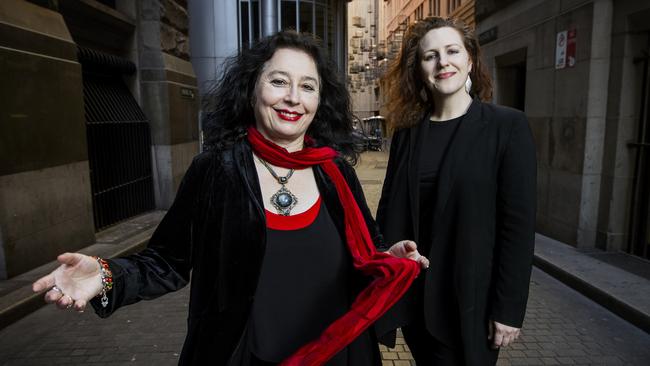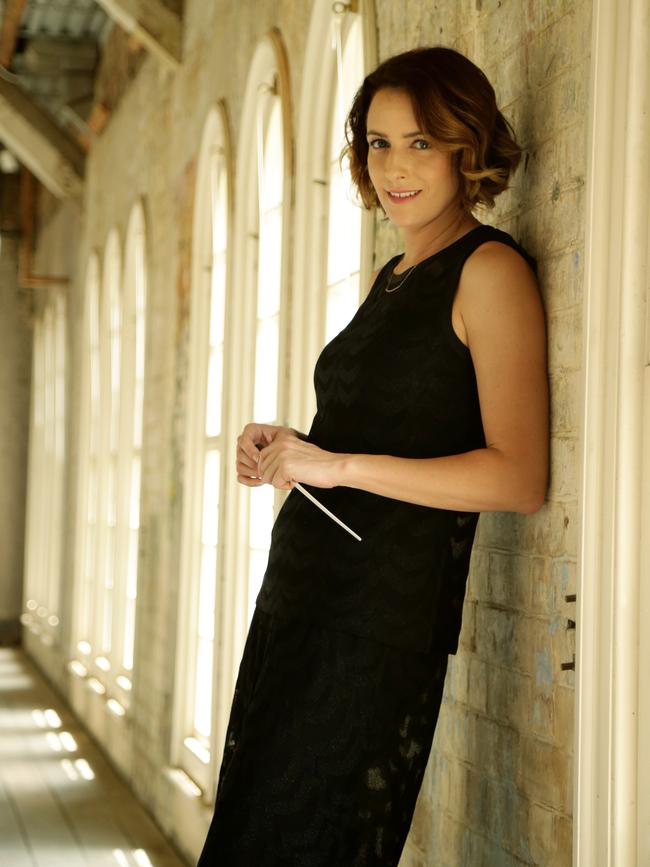Elena Kats-Chernin, pianist Tamara-Anna Cislowska concerto, Bach’s wife
Two friends and collaborators talk about their relationship and their musical homage to Johann Sebastian Bach’s wife.

Tamara-Anna Cislowska has just come off the stage at the City Recital Hall in Sydney, having been the piano accompaniment to soprano Greta Bradman in an afternoon concert of art song. She’s greeting people in the foyer when Elena Kats-Chernin comes through the door. They embrace warmly.
The two women with the double-barrelled names have been friends and artistic collaborators for years. They met not long after Kats-Chernin, a composer, had returned to Australia after living and working in Germany. Cislowska was then still a teenager and recalls being introduced to Kats-Chernin, over the phone, by record producer Belinda Webster.
“She had quite a thick accent and she liked to talk a little bit quickly,” Cislowska says of their first conversation.
“She was still a teenager,” Kats-Chernin says.
“Elena thought I sounded very mature because I didn’t start becoming childish until much later in life. I was a very mature 16-year-old.”
“And I was very new coming back to Australia,” Kats-Chernin says. “I didn’t know many people yet because I was away from Australia for 14 years.” She looks at Cislowska. “I was excited to talk to you.”
“The finale of that little story,” Cislowska says, “is that I agreed to perform Elena’s Variations in a Serious Black Dress without really knowing that I had done so.”
Cislowska and Kats-Chernin head for the cafe outside the hall, where some of the afternoon’s audience also have gone for coffee. Some approach Cislowska to tell her how much they enjoyed the concert, and they say hello to Kats-Chernin, too. Dressed in black, as she often is, and with a slash of bright red lipstick, she’s the most recognisable of Australian composers.
The two recently performed together in a concert and on a double CD called Butterflying, an eclectic album of Kats-Chernin’s piano solos and duets. Their latest venture is a new piano concerto that Cislowska will perform with the Queensland Symphony Orchestra, with that orchestra’s music director, Alondra de la Parra, conducting. A repeat performance with the Tasmanian Symphony Orchestra in November will be conducted by Karina Canellakis.
Kats-Chernin has written two previous concertos for piano, performed by Stephanie McCallum and Ian Munro respectively. She has written concertos for other instruments, too, always with an ear for the soloist and the particular qualities they can bring to the performance.
“I was very lucky because for each concerto I knew for whom I was writing,” she says. “Because I come from the theatre world” — her years in Germany were spent mostly as a theatre composer and pianist — “I can imagine the stage, almost to the point of what they (the soloist) are going to wear, how they move their hands, if they throw their hair around.”
What does she notice about Cislowska’s playing?
“First of all, there is this incredible musicianship,” she says. “She understands the gist of a piece, or the gist of a note. She produces sound out of the crappiest piano and makes it sound magnificent. She makes it sound divine.”
“That makes me laugh,” Cislowska says.
Cislowska has been surrounded by music, especially the piano, all her life. Her mother is esteemed piano teacher Neta Maughan, and Tamara gave her first public performance at the Sydney Town Hall when she was two or three. “Tamara has an amazing Russian technique,” Kats-Chernin continues. “This incredible hand which can play anything. It’s a big hand.”
“Featuring a leg of lamb for a thumb,” Cislowska says, flexing her thumb muscle. She does indeed have strong-looking hands. “Slightly oversized. The palm is where the sound comes from. If you’ve got a skinny palm, it’s more difficult.”
“I call it the divine three,” Kats-Chenin says. “The head, the heart and the hand. She has this incredible ability to connect them all.”
The piano concerto is not an abstract piece of concert music: it has a program. Cislowska and Kats-Chernin have created a musical homage to Maria Barbara Bach, first wife of Johann Sebastian Bach and mother of seven of his 20 children.
At the time, Bach was kapellmeister or chief musician to Prince Leopold of Anhalt-Kothen and had accompanied him to the spas in Carlsbad. While he was away, Maria Barbara died and Bach did not learn of her death until he returned, by which time she had been buried.
Cislowska mentions the theory that Bach’s Chaconne in D minor — one of the most extraordinary pieces of music for solo violin, and so different in character from the preceding movements of the second partita of which it is part — was intended as a memorial to his wife.
“I started thinking about Maria Barbara and about the circumstances Bach found himself in,” Cislowska says. “Going away, coming home, and your little kid goes: ‘Mummy died.’ And not only died, she’s already been buried. I wonder what that does to someone — anger, despair …”
“Guilt, I would say,” Kats-Chernin says.
“Loss. Regret.”
“Your whole life changes.”
The concerto, which has the title Lebewohl, or Farewell, is in five movements which, Cislowska says, roughly correspond to the stages of grieving. The first is full of shock, the second slow and subdued as the sense of loss is sinks in. Subsequent movements are, respectively, anxious, reflective and finally redemptive.
“At one point,” Kats-Chernin says, “it’s as if you are playing stars — the sound of stars at the top of the piano range, with pizzicato strings, harp and glockenspiel. It’s a starry atmosphere, sort of heavenly.”

De la Parra, speaking on the phone from Brisbane, has programmed Kats-Chernin’s concerto with an orchestral favourite, Beethoven’s Symphony No 7, and Prokofiev’s Classical Symphony. “There is a parallel between Elena’s new concerto and the Prokofiev, in that Prokofiev was looking back to the music of the baroque,” she says. “Even though it’s called the Classical symphony, he was looking to the music of Bach and his contemporaries.”
Kats-Chernin’s piece likewise draws on elements of baroque style. Cislowska describes a passage in the piano part that flies up and down the keyboard, enlivened with Kats-Chernin’s rhythmic drive and syncopation. Another part, Kats-Chernin says, has a pedal note and repeated diminished chords that take their time to resolve. She also has used the letters in Maria Barbara’s name and transcribed them into musical code, just as Bach did with the B-A-C-H motif that he used in his own works.
Cislowska prizes one quality in Kats-Chernin’s music above all else: a “wildness and strength” that she discovered in the first piece she played, Variations in a Serious Black Dress.
“I was very struck by the vibrancy, that larger-than-life quality about you,” she says, looking at her friend across the cafe table. “If you have that creative spark, I think performers feel it too. You find some connection with the music. I don’t really know why. If you think you know why, you’re probably not doing it.”
“You lose the magic,” Kats-Chernin agrees.
“I think it’s important to hover in that vicinity between knowing and not knowing.”
“I like that,” Kats-Chernin says. “That’s a great line.”
Tamara-Anna Cislowska plays Elena Kats-Chernin’s Piano Concerto No 3 with the Queensland Symphony Orchestra on September 6, and with the Tasmanian Symphony Orchestra on November 9.
